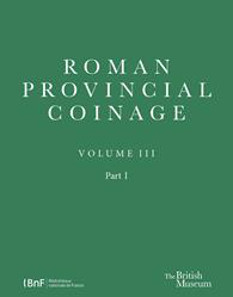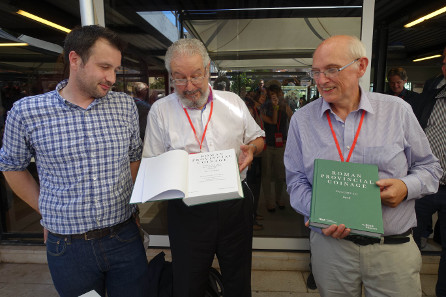[bsa_pro_ad_space id=4]
by Ursula Kampmann
translated by Annika Backe
October 29, 2015 – What the RIC is for Imperial coins, the RPC is for coins from the Roman Provincial cities and corporations. Do I have to go on writing? Perhaps I should because many collectors may not be aware of the fact that the Roman monetary system was not that straightforward as one might be inclined to believe when making the first steps as a collector. It is true, the denarius was circulating everywhere in the Roman Empire, but there was any number of local currency in use as well, featuring a wide range of subjects which makes every present-day numismatist rejoice. However, there is one problem: keeping track of all those coins was a hard thing to do – indeed ‘was’, for under the rule of Nerva, Trajan and Hadrian, this situation was already a matter of the past. Now, every coinage minted in the Roman provinces during that period of time is documented in Volume III of the RPC.
Michel Amandry and Andrew Burnett, Roman Provincial Coinage III; Nerva, Trajan and Hadrian (AD 96-138). British Museum Press London / Bibliothèque nationale de France Paris 2015. 1,368 pages, 356 b/w plates, 5 maps. 2 vols., hardcover in slipcase. 22.5 x 28 cm. ISBN 978 0 7141 1827 7. 195 pounds.
Responsible for this weighty catalog are two doyens of numismatics: Michel Amandry, former head of the Cabinet des Médailles of the Bibliothèque nationale in Paris, and Andrew Burnett, former Deputy Director of the British Museum. A greater reputation on such a limited space is hard to imagine. It does not need special mentioning that the work and the research results of countless colleagues – above all, Jerome Mairat – also had a considerable influence on this magisterial volume. This makes the catalog weighty in more than one regard. Its content will become the pivotal element of future study. Given that the two parts span 1,368 pages and 356 plates, even the most solid bookshelve will be stretched to its limits when it has to support all released RPC volumes.
Presentation of the new RPC, on the occasion of the Numismatic Congress in Taormina. Jerome Mairat to the left, Michel Amandry in the middle, and Andrew Burnett to the right. Photograph: UK.
The weight corresponds to the material that has been accessed: 50,000 coins, divided into nearly 6,500 catalog entries – these numbers alone make everybody who has tried to prepare a catalog once, freeze with respect. When considering the diligence with which the coinage of every single city is presented, one starts brooding over the effort put in this RPC.
Let us single out only one example – not arbitrarily for the reviewer still harbors a special fondness for Pergamon… Well then, Pergamon. No, you won’t find Pergamon under the heading Mysia as you are accustomed to in the auction sale catalogs. The RPC reflects Roman conditions. The cities of the Province of Asia, therefore, are dealt with in one chapter, divided according to the different conventus (=court district). In terms of administration, Pergamon worked closely with cities which, in accord with good old Head – and our modern auction sale catalogs –, were located on the island of Lesbos and Chios, and in areas which we know as Lydia and Aeolis. And this makes perfect sense, as becomes evident by a look at the location of the court district on the map. The fact that this cataloguing, following ancient reality, can reveal a whole new range of connections becomes clear for everybody to see!
All those who find this rather complicated benefit from an index where every city is listed separately. Speaking of indices: spanning a good 100 pages, they almost make a book of their own! Everything you desire of an index is provided: cities, rulers, inscriptions, names and titles, types, countermarks; anyone who has ever written an index knows very well how much effort it takes. And anyone who uses books not just for decoration knows how essential a comprehensive index actually is.
But we are deviating from the subject, so let us get back to Pergamon. The contribution starts by briefly summarizing the most important bibliography dealing with the coinage of this city. Different groups of coinages – linked by minting authority, titles or the lack of a portrait – are then dealt with more thoroughly. The different denominations are listed according to the emperors. Next comes the catalog proper, providing all essential numismatic specifications: metal, diameter, average weight, die axis, description, specimens from the different collections, and – if necessary – a commentary. It goes without saying that illustrations are given for every single coin type.
As you can see, dear reader, I am waxing lyrical. I have fallen in love with this incredible catalog project which makes it abundantly clear that Roman history does not only consist of the lives of emperors but of the accomplishments of countless people from the most diverse backgrounds that considered themselves citizens of their town first, and only then Romans.
Oh yes, there is one thing I would recommend: if possible, order a copy today. Anybody who has missed to buy Volume II knows that a reasonably priced copy is currently very hard to come by.
You may place an order for the RPC volume
at Spink.





